Focke-Wulf Fw 190 A-0
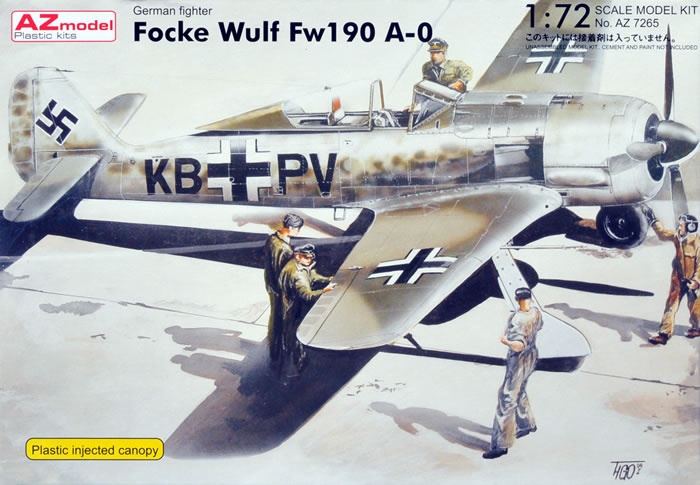
AZ Model, 1/72 scale
S u m m a r y : |
Catalogue Number: |
AZ Model Kit Number AZ7265 - Focke-Wulf Fw 190 A-0 |
Scale: |
1/72 |
Contents & Media |
41 x grey styrene (airframe), 2 x clear styrene (canopy), 2 x resin (cockpit tub & wheel-wells), 1 x fine metal tube (gun blast tubes) and decals for four subjects |
Price: |
Available on-line from Hannants for £13.90 and Modelimex for €12.61 |
Review Type: |
First Look |
Advantages: |
Very good quality moulding for limited run, with refined surface detail and good interior detail. |
Disadvantages: |
More of a Fw 190A-1 than an A-0. The instructions do not fully reflect the parts correctly or all of what is required for the builder to make an accurate Fw 190A-0. |
Conclusions: |
An attractive subject that should help round out quite few Butcher-Bird collections. |
Reviewed by Mark Davies

HyperScale is proudly supported by Squadron.com
The Fw 190 really needs no introduction. Suffice to say it was real thoroughbred of a fighter that went on to display enormous development potential. It showed everyone else how to install a radial engine in a fighter, as evidenced by such later designs as the La-5/7, Sea Fury and Bearcat. This said, it was the engine installation in the early Fw 190’s that gave the most trouble, and this was certainly the case with the Fw 190A-0. Over heating, fouled sparkplugs and vibration all caused problems, to the extent that continuation of the Fw 190 program was threatened early on. These problems were eventually resolved however, and one of the best fighters of WW2 came into service.
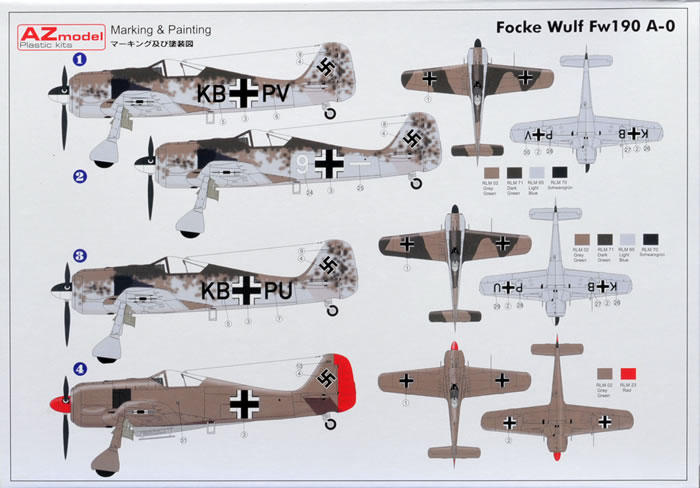
The Fw 190A-0 was really a pre-production development model. The early ones had the small wings of the first prototypes, but most A-0’s had the full-size wing associated with later Fw 190’s. Interestingly this model was quite lightly armed with only four 7.92 mm rifle calibre MG 17’s, although two of these were soon to be replaced by 20 mm cannon in subsequent versions. I have seen photos attributed as Fw 190A-0’s with out-board MG FF 20 mm cannon, if correct this suggests a developmental fitment.
All parts and decals come sealed in a cellophane bag. The styrene parts are some of the best I have seen by AZ Models, being very crisply moulded limited run parts on a single sprue. (There was a moulding flaw at the tip of one of the prop spinners of my example, but a bit of filler will easily fix this). Surface detail is commendably fine, and nice detail is to be found on the inside of the undercarriage doors. Ailerons and flaps are separate parts, which will appeal to those who like these items deflected and open respectively.
The cockpit tub is a very nice one-piece resin moulding incorporating the seat and joystick. Given this, it is perhaps surprising that the two-piece instrument panel is styrene. Whilst this is quite adequate, a PE instrument panel with photo-foil instruments, as is supplied in some AZ kits, would have lifted this kit even higher in the detail stakes. A two-part canopy enables an open cockpit to be displayed.
The resin main-wheel wells are nicely cast and will enhance the finished result. A piece of metal tubing is supplied for the prominent gun blast tubes that run through the wheel well, and this will need to be cut to provide two pieces. A word of caution here – many of the AZ illustrations show the wing guns protruding quite some way from the wing leading edge, whereas my references show that the MG 17’s did not protrude at all.
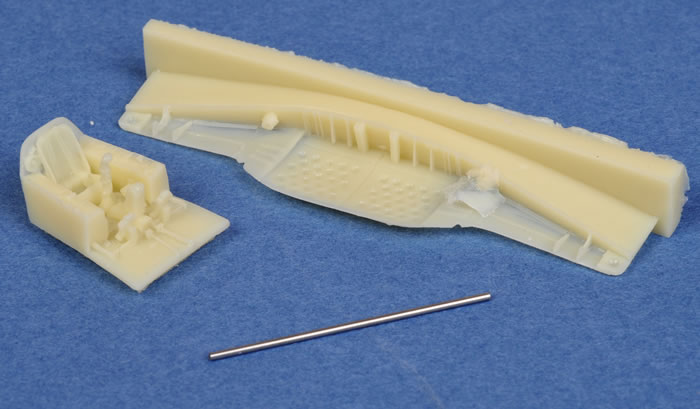
The kit has some very strong resemblances to the earlier Sword Fw 190A-1 with only very minor detail differences, although it seems to be produced to a higher moulding standard. (This is also the case for the AZ fabric wing Hurricane. Many of the Czech limited run kit model producers are friends, and do help and collaborate on projects, and this could apply in this instance).
The parts as supplied are really those of a Fw 190A-1 (the subject of another AZ Models boxing). As such, this kit has the regular sized wing rather than the early small wing fitted to the first Fw 190A-0’s. AZ has addressed some of the key differences between the A-0 and A-1 by supplying a shorter spinner and replacement bulges for the lower sides of the engine cowl (it is necessary to cut and sand away the bulges applicable to the A-1 and later versions).
Unfortunately differences in panel shape at the top of the cowl where it meets the leading edge of the cowling is not represented, yet it is illustrated in the instructions. In fact the instructions show a quite different drawing of the fuselage halves to those supplied, with a for-shortened panel over the fuselage gun breaches, and the gun troughs moulded into the fuselage halves. In fact with the kit parts the breech covers and gun troughs are supplied as one piece. This is not so much a problem as something to be aware of. For a more accurate A-0 you will need to fill and re-scribe in accordance wit the instructional diagram although the instructions don’t mention the need to do so. There are also fewer panel lines in the wings of the A-0 compared to the A-1 and later aircraft due to fewer gun-access panels.
Further minor failings of the instructions are the use of the head armour brace which should be omitted for an A-0, and the need to remove the gun bulges on the underside of the wings, because unlike the A-1 the A-0 did not have these features. Further adding to the confused state of the instructions as they relate to the kit (but not really a problem in this case) is that the sliding canopy hood is first drawn correctly on page 3 as a separate piece. Yet on page 4 the instructions show the option of cutting the windscreen from a one-piece canopy moulding despite the fact the kit supplies the windscreen and hood as separate parts!
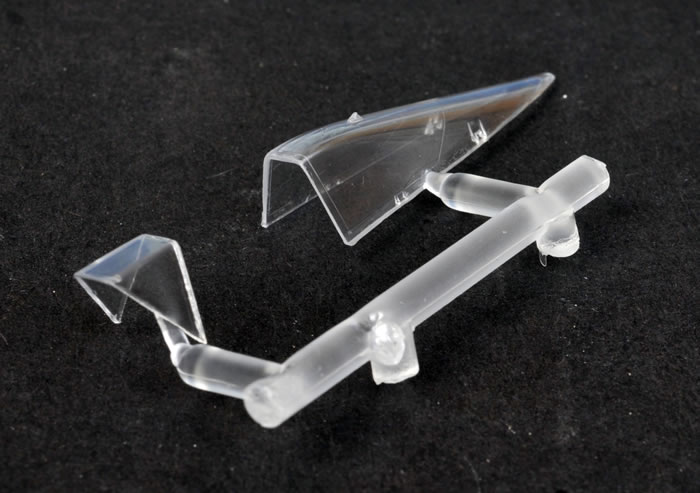
Finally, the instructions do not mention the need for the builder to scratch-build a pitot tube, although this is shown in the various drawings. I think that the instructions were designed and printed before tooling was finalised.
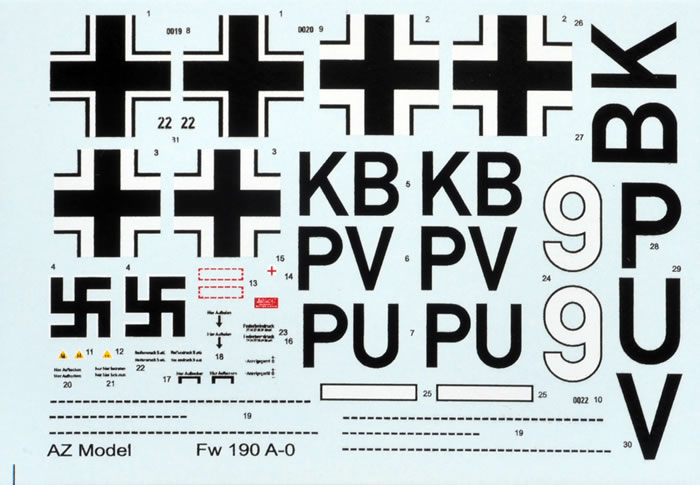
I feel this should be and easy kit to build, and it follows a thoroughly conventional parts breakdown. The decals look to be well registered with good colour density. They are for four aircraft. Three are typical Luftwaffe combinations of disruptive camouflage on upper surfaces with mottled vertical surfaces, and have unit markings. The other is overall RLM 02 with red spinner and rudder, and no unit markings. On the subjects of colour, the instructions advise that the cockpit interior should be RLM 02, this may well be correct as these are early aircraft, but many later Fw 190’s were RLM 66 in this area. It’s something that may be worth checking out before proceeding.
This kit is a welcome addition to the range of 1/72 Fw 190’s already available, and it should build into a nice model. It’s let down a little mainly by its failure to identify the differences the modeller must make to the Fw 190A-1 mouldings as supplied to get an accurate A-0. The contradictory aspects of the instructions are unlikely to hamper the build, but AZ Model should try harder to avoid these types of error as they suggest a lack of care in preparation.
Recommended.
Thanks to Legato / AZ Models for the sample
Review Text Copyright © 2009 by Mark Davies
Page Created 28 June, 2009
Last updated
28 June, 2009
Back to HyperScale Main Page
Back to Reviews Page

|
Home
| What's New |
Features |
Gallery |
Reviews |
Reference |
Forum |
Search